2.4 Carbon Neutral Port (CNP)
What is Carbon Neutral Port (CNP)?
In October 2020, Japan declared its aim to "reduce greenhouse gas emissions to net-zero by 2050, that is, to achieve a carbon-neutral, decarbonized society by 2050."
In ports, it is necessary to developing competitive ports that are chosen by shippers and shipping companies by promoting initiatives such as decarbonization of port facilities in response to the needs of shippers and others who are working on decarbonization of the entire supply chain. Furthermore, industries that emit large amounts of greenhouse gases are gathered in ports and coastal areas. It is important to contribute to the transformation of industrial structures and the strengthening of competitiveness by developing the necessary environment in ports for the supply of hydrogen, ammonia, etc. required for the energy transition of industries.
Therefore, to contribute to the strengthening of the competitiveness of Japan's ports and industries and the realization of a decarbonized society, the Ministry of Land, Infrastructure, Transport and Tourism is promoting the Carbon Neutral Port (CNP) initiative that aims to enhance decarbonize terminal operation and develop an environment for receiving hydrogen, ammonia, etc.
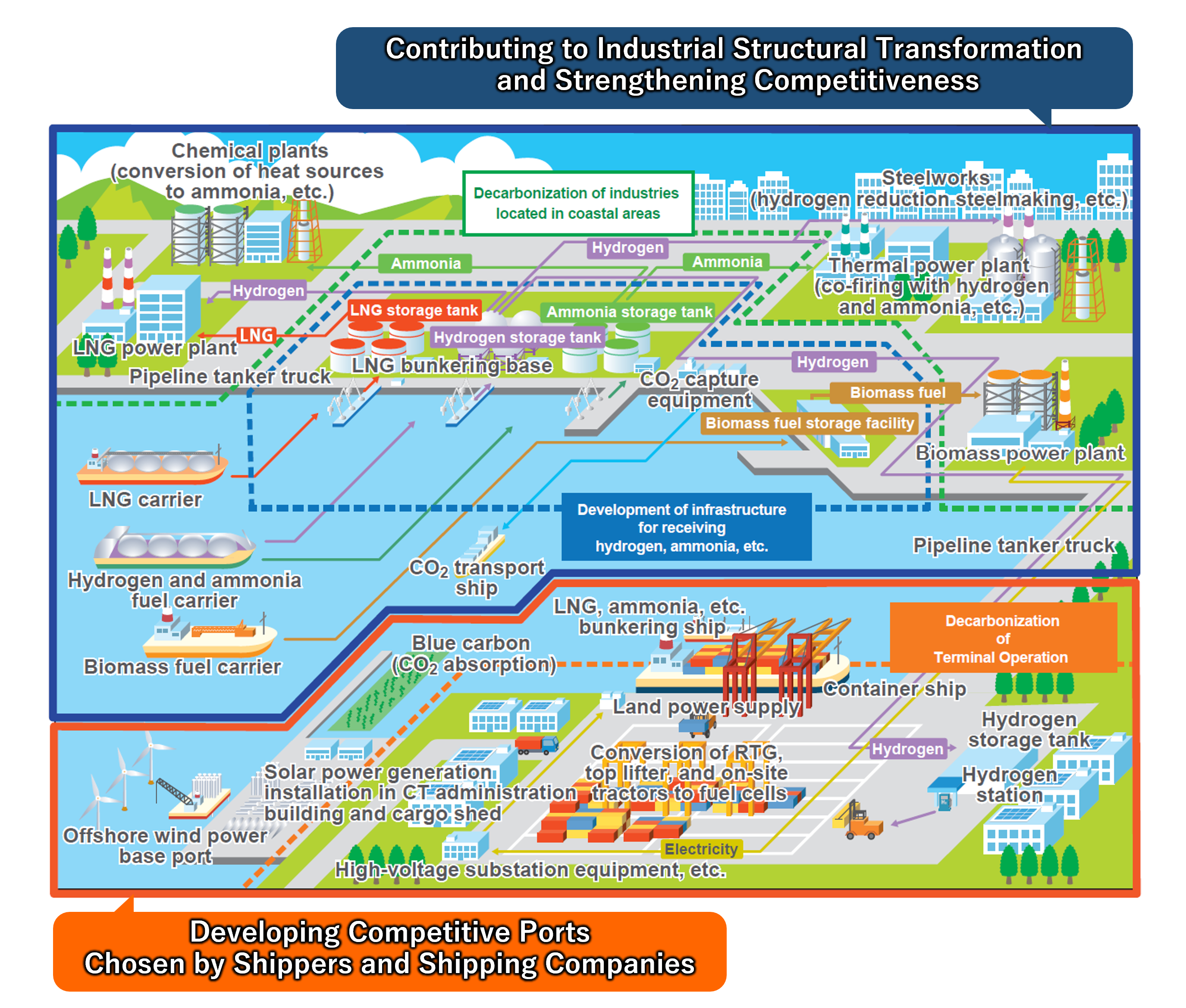
Developing Competitive Ports Chosen by Shippers and Shipping Companies
Ports are hubs of international supply chains, with over 99% of import and export cargo passing through them. Shipper companies are working to decarbonize their entire supply chains, and ports are also required to respond to the needs of decarbonization.
To develop competitive ports that are chosen by shippers and shipping companies, the public and private sectors are working together to promote initiatives for decarbonization of terminal operation.
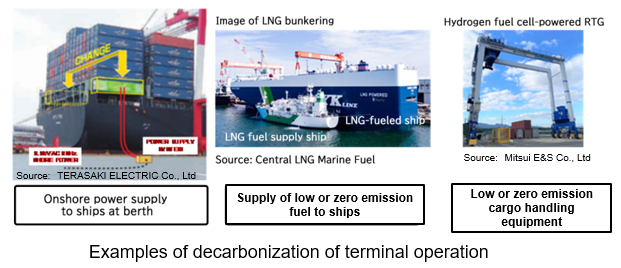
Contributing to Industrial Structural Transformation and Strengthening Competitiveness
Many industries that account for about 60% of CO2 emissions are concentrated in ports and coastal areas. These industries are promoting an energy transition from fossil fuels to hydrogen, ammonia, and other energy sources for decarbonization. To build large-scale supply chains for hydrogen, ammonia, and other energy sources, it is necessary to first develop a receiving environment in ports.
To contribute to the transformation of industrial structures and the strengthening of competitiveness, the public and private sectors are working together to promote initiatives for developing a receiving environment for hydrogen, ammonia, and other energy sources in ports.
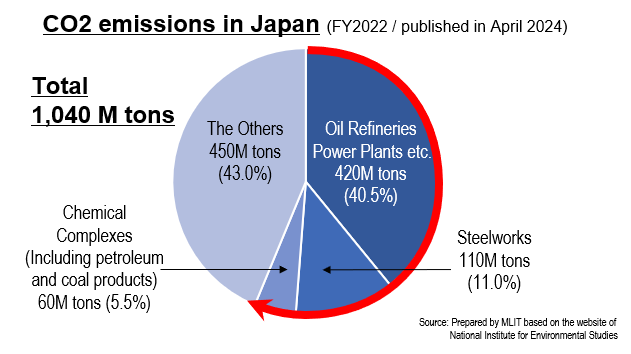
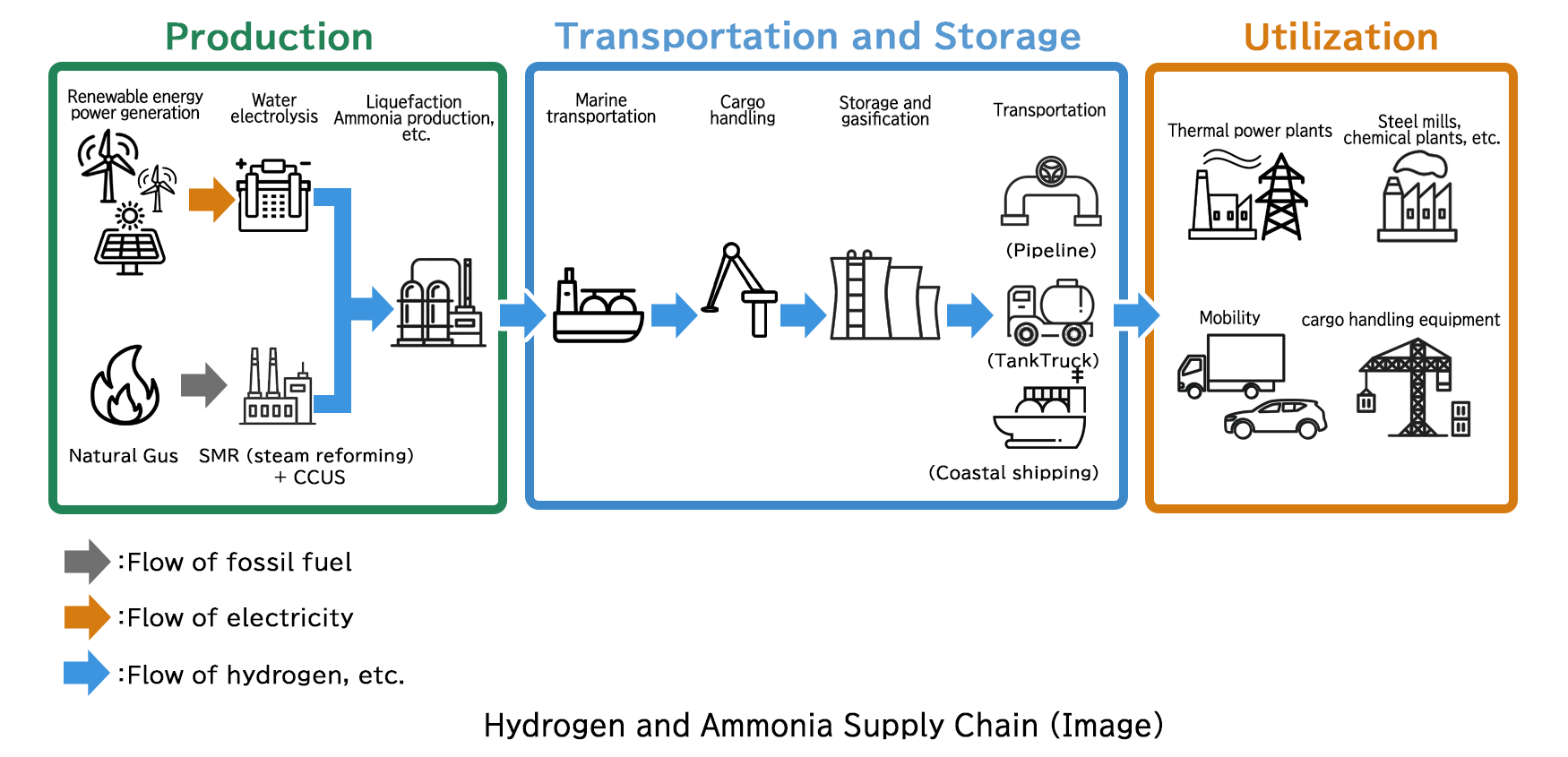
■CNP Certification (Container Terminal)
As one of the initiatives to promote the development of CNP, the "Study Group for the Establishment of a Certification System for the Decarbonization of Port Terminals." has been holding repeated discussions toward the establishment of a certification system. Based on the discussions so far, the "CNP Certification (Container Terminal)" has been compiled and the system has been launched.
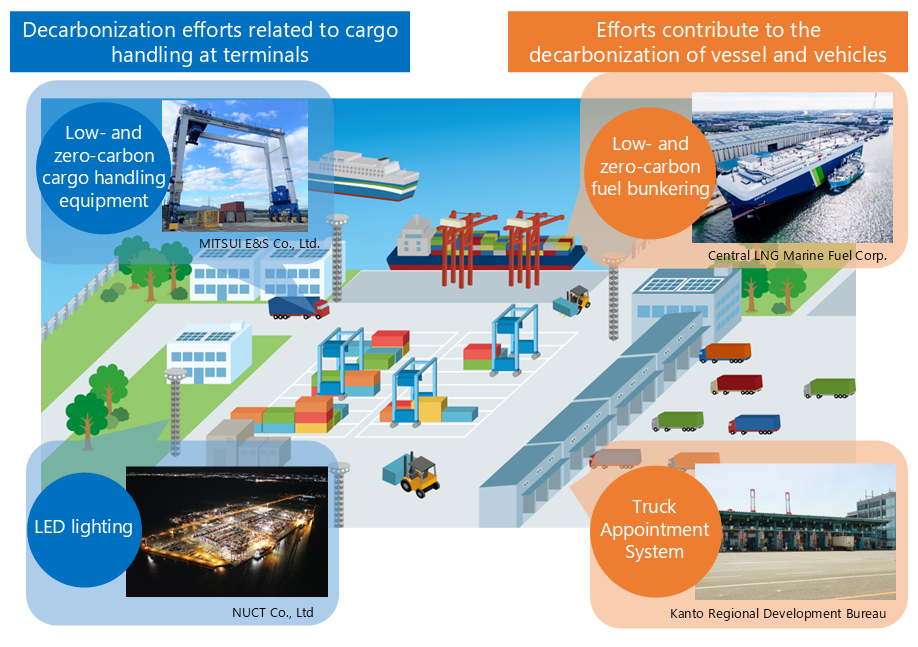
For the detail, please visit CNP certification portal site.
(↓Please click this logo mark.)
2.4.1 Blue Carbon Ecosystems
In recent years, efforts to reduce greenhouse gas emissions have been promoted, and so-called "blue carbon" has been attracting attention worldwide. This term refers to carbon captured by marine plants and other organisms that inhabit seaweed beds and other habitats in coastal areas.
Japan's coastal areas, which are open to the sea on all sides, have high potential for blue carbon ecosystems. The government aims to include this CO2 absorption by blue carbon in the inventory*1 under the United Nations Framework Convention on Climate Change (UNFCCC) and NDC*2 under the Paris Agreement. In addition, efforts will be made to create a favorable marine environment by effectively utilizing resources such as dredged sediments and creation and preservation of seaweed beds and other habitats for the blue carbon ecosystem.
Furthermore, based on the Act on Facilitating Research and Development in Basic Technology, the government will promote new decarbonization efforts using blue carbon ecosystems in cooperation with the Japan Blue Economy (JBE) Technology Research Association, which was approved by the Minister of Land, Infrastructure, Transport and Tourism in July 2020. These include a quantitative evaluation method for blue carbon and a trial of a blue carbon offset credit system for trading blue carbon.
*1. Inventory: According to the United Nations Framework Convention on Climate Change, an inventory showing the actual amount of greenhouse gas emissions and sinks by source and sink.
*2. Nationally Determined Contribution (NDC): According to the Paris Agreement, "nationally determined contribution" with respect to greenhouse gas reduction targets.

2.4.2 LNG Bunkering Development
■Development of LNG bunkering bases with a view to conversion to LNG-fueled vessels

The International Maritime Organization (IMO) decision (October 2016) has tightened international environmental regulations for vessels; such as regulations on SOx (sulfur oxides) emissions from ships in general marine areas will be tightened starting in 2020. Consequently, the number of vessels fueled by liquefied natural gas (LNG) is expected to increase.
Starting in FY2018, a subsidy program was established for the development of facilities needed to form LNG bunkering hubs in Japanese ports, taking advantage of the country's position as the world's largest importer of LNG. In June 2018, two projects were adopted: the LNG Bunkering Project in Ise and Mikawa Bays and the LNG Fuel Supply Project for Ships in Tokyo Bay under the STS Method.
For these projects, Japan's first Ship to Ship (STS) method of LNG bunkering was implemented in Ise and Mikawa Bays from October 2020. This project has been ongoing, creating an LNG bunkering hub. Also in Tokyo Bay, the construction and operation of LNG bunkering vessels are under preparation with the aim of putting the project into service at the earliest possible date. In FY2021, the LNG Bunkering Project in Kyushu and Setouchi Area based in Kitakyushu was adopted as the relevant subsidy program.
2.4.3 Promoting the Introduction of Offshore Wind Power
Due to the potential for mass adoption, lower costs, and economic ripple effects, offshore wind power generation is expected as a trump card for making renewable energy, the main source of power, and has been rapidly introduced and expanded worldwide
■Development of the environment for introducing offshore wind power generation
The Port and Harbor Act was amended in 2016 to improve the environment for the introduction of offshore wind power. The government established a system to select, through public solicitation, those who will occupy port areas for offshore wind power generation. In 2018, the Act on Promoting the Utilization of Sea Areas for the Development of Marine Renewable Energy Power Generation Facilities (Sea Areas Utilization for Renewable Energy Act) was enacted. The Act established uniform rules for the occupation of general sea areas as well.
A "virtuous circle" will be created in which the planned and continuous introduction and expansion of offshore wind power generation will be achieved while simultaneously enhancing competitiveness and reducing costs. To this end, a "Public-Private Council for Enhancing the Industrial Competitiveness of Offshore Wind Power" was established to facilitate dialogue between the public and private sectors. Based on the discussions at the Council, the "Offshore Wind Industry Vision (1st)" was formulated in December 2020, which indicated that projects of 30 to 45 million kW would be formed by 2040.
While accelerating procedures for the public solicitation of power generation companies for the promotion areas based on the Act on Promoting the Utilization of Sea Areas for the Development of Marine Renewable Energy Power Generation Facilities, the government will also conduct geotechnical surveys of promising areas and expedite the designation of the promotion areas.
■System for designation of base ports and harbors
Construction of increasingly large offshore wind power generation facilities requires ports equipped with quays with a certain load-bearing capacity and hinterlands capable of handling long materials and machinery. Accordingly, the Port and Harbor Act was amended in 2021 to establish a system under which the government designates ports as "base ports and harbors for offshore renewable energy power generation facilities" (base ports and harbors) and allows long-terms (up to 30 years) and stable leasing of wharves at base ports and harbors to power companies.
The Ports and Harbours Bureau will continue to develop port facilities, such as quays and loading docks, capable of handling heavy equipment and machinery.

